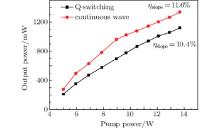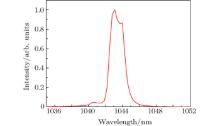Corresponding author. E-mail: jrtian@bjut.edu.cn
Corresponding author. E-mail: yrsong@bjut.edu.cn
Project supported by the National Basic Research Program of China (Grant No. 2013CB922404), the National Natural Science Foundation of China (Grant No. 61177047), and the Beijing Municipal Education Commission Project, China (Grant No. KM201010005007).
We present a passively Q-switched Yb:KGW laser based on a transmission-type saturable absorber of topological insulator: Bi2Se3. The saturable absorber is prepared on a 0.17-mm glass substrate and can translate intra-cavity for best performance nearly without influence on the laser mode. At a maximum pump power of 13.7 W, the central wavelength, pulse duration, repetition rate, and pulse energy of Q-switched pulse are 1043 nm, 1.5 μs, 175.4 kHz, 6.39 μJ, respectively. The maximum output power is 1.12 W. To our knowledge, this is the highest average output power from passively Q-switched lasers with topological insulator saturable absorbers.
Yb-doped KGd(WO4)2 laser material is well suited to build diode-pumped pulse lasers in watts region[1] because of its large optical absorption, large emission cross section, [2] broad gain bandwidths of 24 nm, and good thermal conductivity of 3.3 W/m· K. These desirable properties have proved that the Yb:KGW laser is good for a number of applications, [3– 6] and quite a few Yb:KGW lasers have been reported.[7– 9]
Pulsed lasers have been obtained by a semiconductor saturable absorber mirror, [10, 11] carbon nanotubes, [12] graphene, [13, 14] a combination of graphene and nanotube, [15] etc. Recently, efficient and stable pulsed lasers based on topological insulators have attracted much attention because of their potential applications in lasers. A topological insulator is a material with the characteristics of time-reversal symmetry and non-trivial topological order, which behaves as an insulator in its interior while displaying conducting states on its surface.[16] Importantly, experiments with this laser have revealed its saturable absorption for light and large modulation depth, which implies a topological insulator and can be used in lasers to realize pulsed operation. Saturable absorbers based on topological insulators have the advantages of low saturation intensity, broad effective bandwidth, easy fabrication, and low cost. Until now, topological-insulator saturable absorbers (TISA) have been used for mode-locking[17– 22] and Q-switching in fiber or solid-state lasers.[23, 24] However, the output power has been limited to a few tens of milliwatts.
In this paper, we report a passively Q-switched Yb:KGW oscillator based on the transmission-type TISA of Bi2Se3. The transmission-type TISA is prepared in a 0.17-mm glass substrate translating intra-cavity, which makes it possible to adjust the position of TISA for the best performance while the influence on the laser mode can be neglected. In this configuration, passive Q-switched pulses as short as 1.5 μ s and an average output power of 1.12 W are obtained. To our knowledge, this is the highest output power for diode-pumped bulk Yb:KGW laser by TISA so far.
Our experimental configuration is shown in Fig. 1. A 976-nm multimode fiber-coupled continuous wave (CW) diode laser was used to pump the Yb:KGW oscillator through a coupling system composed of lens 1 and lens 2. X is a Yb:KGW crystal with a size of 3 mm× 3 mm× 10 mm and 5 at.% doping concentration, which was mounted on a water-cooled heat sink at 13.6 ° C. Sub is a 0.17-mm glass substrate coated with TISA of Bi2Se3. The cavity consisted of two mirrors: M1 and M2. M1 was a plane dichroic mirror with high transmission for the pump wavelength of 976 nm and high reflectivity for the laser. The concave mirror M2 with a radius of curvature (ROC) of 100 mm was an output coupler with a transmission of 5%. The total length of the resonator was 68 mm.
Passive Q-switching was achieved with the TISA on the substrate. The procedure to prepare TISA film has been described in Refs. [25] and [26]. The substrate was mounted on a linear stage with a travel range of 50 mm so as to translate intra-cavity for best performance. Since the substrate was very thin, the influence on the laser mode could be neglected. The modulation depth of TISA was measured by the Z-scan technique. Figure 2 shows the schematic diagram of Z-scan system [Fig. 2(a)] and the nonlinear transmission for samples with TISA [Fig. 2(b)]. The modulation depth of TISA was estimated to be about 5.4%.
We first measure the continuous-wave output power with respect to pump power without the TISA component. The pump threshold is measured to be 4.02 W. With the pump power increased to 13.7 W, the output power increases up to 1.339 W. The optical-to-optical efficiency is about 9.8% and the slope efficiency is about 11.6%. After an appropriate collimation, we insert the substrate coated with a TISA film. To lower the loss introduced by the substrate, we finely tune the tilt angle of the substrate so that the laser is incident on it at Brewster angle. Afterwards, finely tuning the position of the TISA, Q-switching occurs. With the Q-switching operation, the pump threshold increases up to 5.02 W. The highest output power is 1.12 W, corresponding to an optical-to-optical efficiency of 8.2% and a slope efficiency of 10.4%. Figure 3 shows the average output powers for continuous wave and Q-switching operation versus pump power. Note that the output power of Q-switched laser is less than that of CW laser, due primarily to the loss introduced by the thin glass substrate coated with TISA film.
We detect the Q-switched pulse trains with different pump powers by using a digital oscilloscope (54833A, Agilent Technologies) and Fig. 4 shows the result, with repetition rates at pump powers of 8.79 W, 11.3 W, and 13.7 W are 92 kHz, 144 kHz, and 175.4 kHz respectively. From Figure 4 it can be seen that the repetition rate increases as the pump power increases, which is a typical characteristic of passive Q-switching. The corresponding pulse widths can also be deduced to be 3.1 μ s, 2.2 μ s, 1.5 μ s at pump powers of 8.79 W, 11.3 W, and 13.7 W, respectively. The pulse width of 1.5 μ s is the shortest pulse width obtained in experiment when the pump power reaches a maximum power of 13.7 W. At a pump power of 13.7 W, the pulse energy can be calculated to be about 6.39 μ J. Figure 4(d) displays the long-term Q-switched pulse trains at a maximum output power, in which the fluctuation is very small, which implies the stability of the Q-switched pulse.
 | Fig. 4. Detected Q-switched pulse trains at pump powers of (a) 8.79 W, (b) 11.3 W, and (c) 13.7 W; (d) stable long-term pulse trains at a pump power of 13.7 W. |
Figure 5 shows the repetition rate and pulse width of Q-switched pulses versus incident input power. With the pump power increased from 5.95 W to 13.7 W, the corresponding repetition rate increases from 41.7 kHz to 175.4 kHz, while the Q-switched laser pulse width decreases from 3.1 μ s to 1.5 μ s. This is a typical characteristic for passively Q-switched laser, i.e., the repetition rate varies with pump power, which is different from that for the mode-locked lasers, [27, 28] whose repetition rates depend on cavity length instead of pump power. However, when the pump power ranges from 5.95 W to 8.79 W, the pulse width increases somewhat, which is due probably to the repetition rate increasing more rapidly than pump power in proportion, and thus the pulse energy slightly decreases. Therefore, the Q-switched pulse cannot absorb the energy of inversion population rapidly, resulting in a larger pulse width.
We measure the spectrum of the Q-switched pulses with a spectrometer (S2000, Ocean Optics) with a resolution of 0.8 nm. Figure 6 shows a typical result, in which we can see that the central wavelength is around 1043.4 nm and the spectrum width (FWHM) is about 1.8 nm. It is noteworthy that in the experiment the central wavelength has a shift of 1.4 nm with an increase in the pump power.
In this paper, we prepare a transmission-type TISA of Bi2Se3 on a 0.17-mm substrate. The saturable absorber can translate the intra-cavity freely for best performance with an negligible influence on laser oscillation. The transmission-type of TISA is inserted into a bulk Yb:KGW laser, and Q-switching is obtained. At a maximum pump power of 13.7 W, the pulse duration, pulse repetition rate, and pulse energy are 1.5 μ s, 175.4 kHz, and 6.39 μ J, respectively. Benefiting from the design, the maximum output power is measured to be 1.12 W. To the best of our knowledge, this is the highest average output power obtained from passive Q-switched lasers with topological insulator saturable absorbers. Our experimental results demonstrate the possibility of realizing watt-level topological-insulator-assisted pulsed lasers. And we believe that this design may be used for building topological-insulator assisted solid-state lasers with higher output powers.
| 1 |
|
| 2 |
|
| 3 |
|
| 4 |
|
| 5 |
|
| 6 |
|
| 7 |
|
| 8 |
|
| 9 |
|
| 10 |
|
| 11 |
|
| 12 |
|
| 13 |
|
| 14 |
|
| 15 |
|
| 16 |
|
| 17 |
|
| 18 |
|
| 19 |
|
| 20 |
|
| 21 |
|
| 22 |
|
| 23 |
|
| 24 |
|
| 25 |
|
| 26 |
|
| 27 |
|
| 28 |
|







